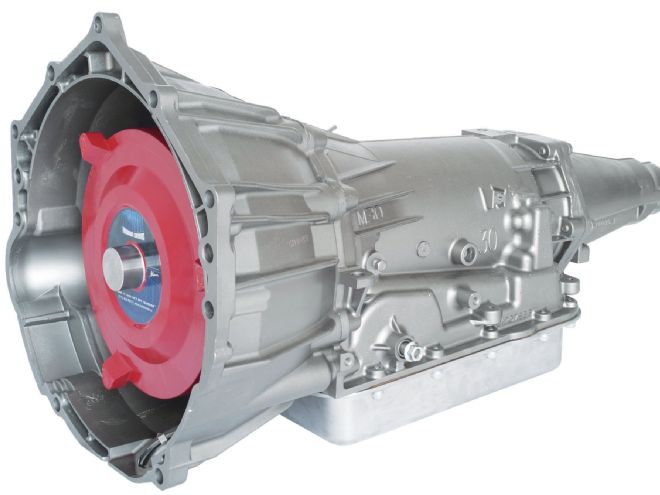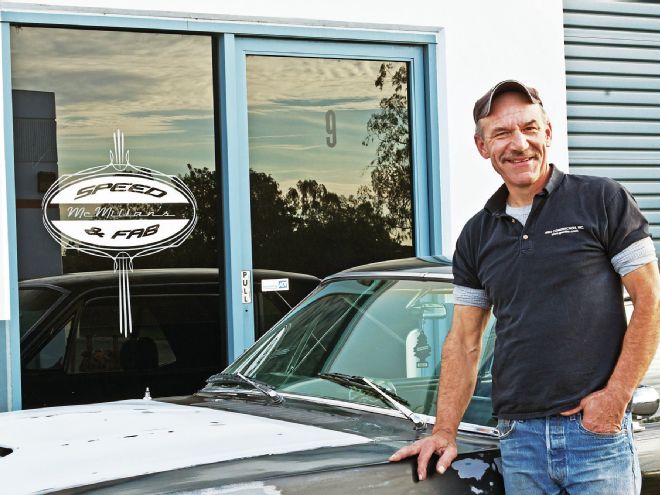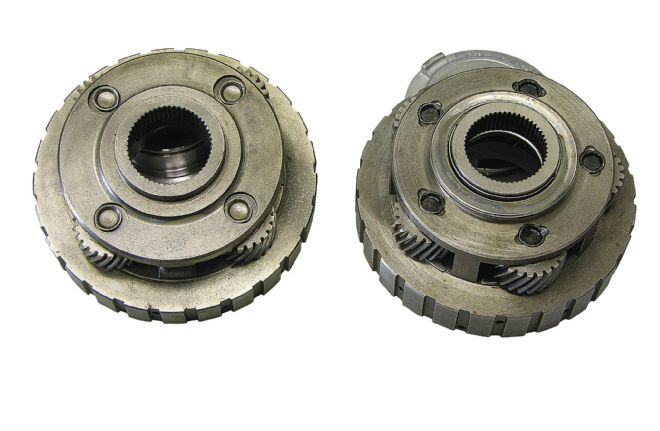
The ’82–’89 Turbo-Hydramatic TH700-R4, ’90–’91 4L60, ’92–’00 electronic 4L60E, ’01–’05 4L65E, and the ’06-and-newer 4L70E were all designed to replace the tried-and-true TH350. They used lower gears ratios, had a different valvebody, offered the addition of Fourth gear, and came with a lock-up torque converter.
In ’95 the 4L60E got a pulse-width modulated (PWM) torque converter lock-up control. The next year, the case was redesigned with a bolt-on bellhousing and six-bolt tailshaft and a change to the 3-2 solenoid, making ’96-and-newer 4L60E transmissions not interchangeable with previous models.
 On most high-performance 4L60E transmissions, a reinforcement sleeve (right) is added to increase the strength of the clutch housing. Additional clutches are added to spread the friction and heat generated during positive shifts.
On most high-performance 4L60E transmissions, a reinforcement sleeve (right) is added to increase the strength of the clutch housing. Additional clutches are added to spread the friction and heat generated during positive shifts.
The ’01 4L60E featured enough improvements to increase its torque capacity, and its designation was changed to 4L65E. The main improvement of interest to hot rodders is the 4L65E’s five-pinion planetary carrier that replaced the 4L60E’s four-pinion. More pinion gears help to spread the load, allowing 4L65E transmissions to handle more torque than their 4L60E brethren. Additionally, a better 3-4 clutch, improved input shaft, and a deeper pan for more fluid were added.
In ’06 there was another designation change to 4L70E for the four-speeds found in GM rear-drive 1⁄2-ton trucks and SUVs. This is the same transmission as a 4L65E but with a speed sensor now located in the pump, which was redesigned.
Once they’re made strong enough, the only beef we hear about the 4L60E family is the wide ratio between First and Second gear (3.06:1 to 1.62:1). As Mark Walk at Gearstar says, “It leaps like a deer.” While many mods are available for these transmissions, there is little that can be done to shorten up the 1–2 shift—some cars like it, some may not.
 One of the main advantages of the latter 4L65E and 4L70E transmissions is the factory upgrade to the five-pinion planetary carrier (right). The added pinion gear helps to spread the load on the carrier.
One of the main advantages of the latter 4L65E and 4L70E transmissions is the factory upgrade to the five-pinion planetary carrier (right). The added pinion gear helps to spread the load on the carrier.
Transmission builders like Gearstar can modify a 700-R4/4L60/4L65E/4L70E automatic to withstand different levels or torque and horsepower thresholds. Modified transmissions are rated at “levels” from Two on up. A Level Two can withstand up to 450 hp, Level Three up to 500 hp, and Level Four to 650 hp. The breakdown of which mods go into each of Gearstar’s upgrades can be found at its website, Gearstar.net. Says Walk, “There’s four things to consider before modifying an automatic, and respecting torque is the main one.” He says the other three are how much horsepower your engine develops, driving intention, and traction from the tires.
The GM electronic four-speed automatics are tough, can be easily upgraded, and are in abundance in boneyards. As stout as they are, eventually you reach the inherent limits that a 4L60E or 4L65E transmission is designed to withstand, which is around 700 hp at Level 4. “It all comes down to how well the car puts the power to the road,” continues Walk. “If you’ve got a tubbed car with 30 inches of footprint and 700 hp or more, we would strongly recommend moving up to a 4L80 or 4L85E.”
GM Transmission Names
The GM nomenclature for the 4L60E works out like this:
4: Number of forward gears
L: Denotes longitudinal mounting (rear-wheel drive); transverse applications (front-wheel drive) are labeled with a “T”
60: Relative torque rating, which is around 360 lb-ft; the higher the number the stronger the transmission
E: Electronically controlled valvebody
Junkyard ID The 700-R4 and 4L60
700-R4s/4L60s Have:
Four-pin electrical connector and a TV cable attachment
RPO on bellhousing is “MD8”
4L60Es Have:
Multi-pin connector and no TV cable
RPO on bellhousing is “M30”